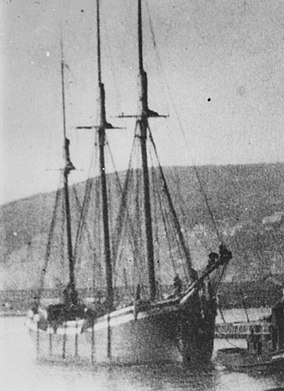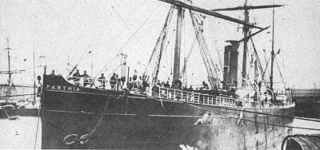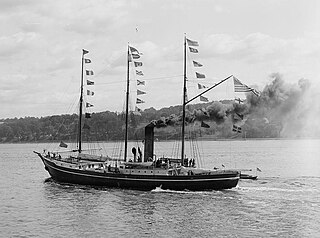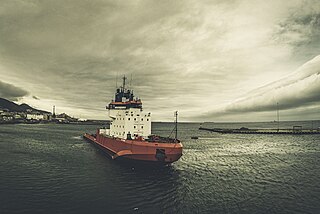
SS Great Britain is a museum ship and former passenger steamship, which was advanced for her time. She was the longest passenger ship in the world from 1845 to 1854. She was designed by Isambard Kingdom Brunel (1806–1859), for the Great Western Steamship Company's transatlantic service between Bristol and New York. While other ships had been built of iron or equipped with a screw propeller, the Great Britain was the first to combine these features in a large ocean-going ship. She was the first iron steamer to cross the Atlantic, which she did in 1845, in the time of 14 days.
Crowley Maritime Corporation, is based in Jacksonville, Florida. Founded in 1892, Crowley is primarily a family- and employee-owned marine solutions, energy and logistics services company, providing services globally. As of July 2016, Crowley was ranked as the 13th largest private company in Florida, employing approximately 5,300 people worldwide with revenues of $2.2 billion. It provides its services using a fleet of more than 300 vessels, consisting of RO-RO vessels, LO-LO vessels, tankers, Articulated Tug-Barges (ATBs), tugs and barges. Crowley's land-based facilities and equipment include terminals, warehouses, tank farms, and specialized vehicles.
Hinchinbrook Island is an island in the Gulf of Alaska lying at the entrance to Prince William Sound in the state of Alaska, United States. The island has a land area of 171.98 sq mi (445.438 km²), making it the 37th largest island in the United States. There was a population of five permanent residents as of the 2000 census.

The Grand Trunk steamship Prince Rupert and her sister ship SS Prince George served the coast of British Columbia and Alaska. Prince Rupert had a 45-year career serving northern ports from Vancouver, British Columbia, from 1910 to 1955. The ship was considered "unlucky" and suffered several incidents during her career, including two significant ones that left large portions of the vessel underwater. The ship was broken up in 1956.

Madeira was a schooner barge that sank off the coast of Minnesota in Lake Superior on November 28, 1905. A schooner-barge is a little-documented type of ship that functions like a barge, in that it is towed by a steamship, but also has sails like a schooner. This type of ship evolved from wooden sailing ships that were cut down into barges and towed behind wooden steamships, a practice which originated in the late 1880s in coastal areas. This design was used in the Great Lakes for transporting grain, iron ore, and other products.

USS Safeguard (ARS-25) was an Diver-class rescue and salvage ship commissioned by the U.S. Navy during World War II. Her task was to come to the aid of stricken vessels.

USNS Apache (T-ATF-172), fifth United States Navy ship of the name, is the last of the Powhatan class of fleet ocean tugs. Apache was delivered to the U.S. Navy in 1981. She is operated by Military Sealift Command and crewed by 18 civil service mariners (CIVMARS). She is designed to provide the Navy with towing service, and when augmented by Navy divers, assist in the recovery of downed aircraft and ships. There are quarters on board for up to 22 additional personnel.

Samuel P. Ely is a shipwreck in Two Harbors, Minnesota listed on the National Register of Historic Places. She was a schooner that sailed the Great Lakes carrying iron ore, coal, and other bulk freight. She was built in 1869 and was a fairly typical example of the 200-foot schooner built in the 1870s, though she was reinforced for the demands of carrying iron ore.
ATL 2701 is a Canadian general cargo barge owned by J.D. Irving Ltd. and operated by JDI subsidiary Atlantic Towing Limited.

Titan was a floating crane that operated in Sydney Harbour from 1919 until 1991. She was fabricated in Carlisle in the United Kingdom, then sent to Cockatoo Island Dockyard in Sydney for assembly, before entering service with the Royal Australian Navy (RAN).
Herakles was a pusher vessel owned by Finnish towing and marine salvage company Alfons Håkans Oy Ab. The ship, originally built as salvage tug Into in 1967, was converted to a pusher in 1991 to be chartered to Rautaruukki Oyj and later ESL Shipping Ltd as the third pusher vessel for the Finnpusku system, a Finnish integrated tug and barge system built in the mid-80s.

The Henry Chisholm was a wooden freighter; it was sunk off the shore of Isle Royale in Lake Superior in 1898 and the remains are still on the lake bottom. The wreck was placed on the National Register of Historic Places in 1984.

Finnpusku is an integrated tug and barge system owned and operated by ESL Shipping, a Finnish shipping company that specializes in bulk cargo transports in the Baltic Sea. The system was developed in the 1980s by Finnlines, another Finnish shipping company that also managed the vessels until 2003, in co-operation with Rautaruukki to transport raw materials to the Raahe Steel Works. Two pushers and five barges, four of which remain in service, were delivered by Hollming in 1986–1987.

Steel is a Finnish pusher vessel owned and operated by ESL Shipping. It is part of the Finnpusku integrated tug and barge system developed in the 1980s by Finnlines, a Finnish shipping company that also managed the vessel until 2003, in co-operation with Rautaruukki for the transportation needs of the steel company. The vessel, built by Hollming in Rauma, Finland, as Finn, was delivered on 28 April 1987 and has since been used mainly to supply raw materials to the Raahe Steel Works.

The Nimbin was a steel screw steamer built in 1927 at Copenhagen, that was the first motor vessel placed into the New South Wales coastal trade. It was owned and operated by the North Coast Steam Navigation Company and was the first Australian registered merchant ship to be lost during World War II when it struck a mine laid by the German auxiliary cruiser Pinguin. The Nimbin was on its way from Coffs Harbour to its home port, Sydney, with a cargo of bundled three-ply timber and a large number of pigs. One third of the ship was blown away and it sank in three minutes. Seven men were killed. The remaining thirteen clung to bundles of plywood. Some hours later an air force plane from RAAF Base Rathmines saw the survivors and directed the coastal ship SS Bonalbo to the scene to pick up the survivors.

The SS Parthia (1870–1956) was an iron-hulled transatlantic ocean liner built for the Cunard Line by William Denny and Brothers in Dumbarton, Scotland. Her sister ships were the Abyssinia and Algeria. Unlike her two sisters, Parthia was smaller, built in a different shipyard and had a slightly different funnel arrangement. The Parthia was retired by Cunard in 1883 and sold to John Elder & Co., who subsequently transferred her to the Guion Line. After serving with the Guion Line and operating on transpacific routes with the Canadian Pacific Railway Company, she was refit and renamed Victoria.
Harbor Clearance Unit One, a United States Navy unit, was commissioned in February 1966 with the mission "....to provide salvage repair; diving and rescue services in rivers and restricted waters and to conduct harbor and river clearance operations in the Western Pacific." Some contended that the intended mission was to provide rapidly deployable diving and salvage teams in direct support of the Vietnam War. Whatever the actual intent was, the concept was proven so effective that the command was moved to continuous salvage service at Pearl Harbor, Hawaii, near the end of the Vietnam War.
SS Frederick Bartholdi was a Liberty ship built in the United States during World War II. She was named after Frederick Bartholdi, French sculptor who is best known for designing Liberty Enlightening the World, commonly known as the Statue of Liberty.

SS Roosevelt was an American steamship of the early 20th century. She was designed and constructed specifically for Robert Peary′s polar exploration expeditions, and she supported the 1908 expedition in which he claimed to have discovered the North Pole.

Kigoriak is a Russian icebreaking anchor handling tug supply vessel. Built by Saint John Shipbuilding & Dry Dock Company for Canadian Marine Drilling (Canmar) in 1979 as Canmar Kigoriak, she was the first commercial icebreaking vessel developed to support offshore oil exploration in the Beaufort Sea.




















